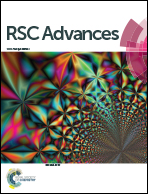Indium chloride catalyzed three-component reaction for the synthesis of 2-((oxoindolin-3-yl)-4,5,6,7-tetrahydro-1H-indol-1-yl)benzamides†
Abstract
In the presence of indium chloride as a Lewis acid catalyst, the three-component reaction of benzohydrazide, cyclic diketones and 3-phenacylideneoxindoles in refluxing acetonitrile afforded functionalized 2-((oxoindolin-3-yl)-4,5,6,7-tetrahydro-1H-indol-1-yl)benzamides in satisfactory yields. Under similar conditions, the reaction with 2-hydroxybenzohydrazide and picolinohydrazide also resulted in corresponding functionalized 2-((oxoindolin-3-yl)-4,5,6,7-tetrahydro-1H-indol-1-yl)benzamides in high yields. The 1H and 13C NMR spectra indicated that the obtained products exist in both a keto-form and an enol-form.


 Please wait while we load your content...
Please wait while we load your content...